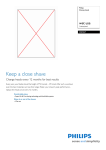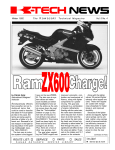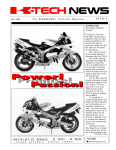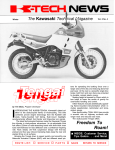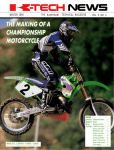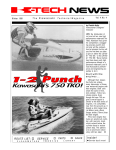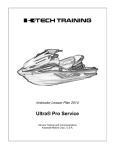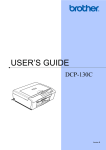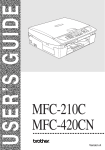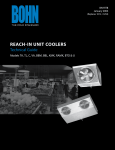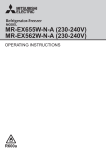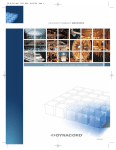Download K-Tech News Vol.4 No.2
Transcript
The Kawasaki Technical Magazine Summer 1991 by Patrick Kelly Instructional Designer/Instructor The JL650-A1, better known as the “Sport Cruiser” or “SC”, is Kawasaki’s latest entry into the growing two-passenger personal watercraft market. The SC’s innovative design proves once again that Kawasaki is the leader in the personal watercraft industry. ROUTE LIST: o P L E A S E SERVICE R E T U R NT O Vol. 4 No. 2 Surely the SC’s most outstanding feature is its unique side-by-side seating arrangement. For the first time in personal watercraft history, riders sit beside each other instead of fore and aft. This exclusive feature allows both passengers to fully share the riding experience-both can see where the craft is headed, and no longer have to shout at each other in order to communicate. If that alone isn’t enough, Kawasaki designed the SC so that either rider can operate the craft without changing seating positions! The boat’s steering wheel can be moved to any one of three positions (left, right, or center) simply by stopping the craft and pulling an adjustment lever before sliding the wheel to another position. The Sport Cruiser shares the same basic drive train as Kawasaki’s other 650 watercraft. ä o PARTS S E R V I C E o SALES L I B R A R Y Inside: n SC explorations! S H O P CONTlNUED FROM PAGE 1 The engine is the familiar 635cc two-stroke twin, with 76mm x 70mm bore and stroke. Other features the SC’s engine shares with the other 650s are CD ignition, 7.2:1 compression ratio, oil injection, crankcase reed induction, T A L K / T E C H N I C A L and a Keihin CDK38-32 carburetor with a 36mm bore. The exhaust system features a “dry” type exhaust similar to the one used on the TS. Water is not mixed with the exhaust gases in this system until the water box. This keeps water out of the tuned portion of the expansion chamber improving performance throughout the rpm range. The SC’s exhaust system also features a stern TECHNICALITIES SC power steering T he JL650-A1 Sport Cruiser’s jet pump steering nozzle features a verticle tab located in the water flow near the nozzle’s pivot axis. This tab is designed to reduce the effort required to steer the craft. When the nozzle is turned, the force of the water exiting the pump pushes on the inner wall of the nozzle, creating a large high-pressure area which tries to force the Without balance tab 2 l K-Tech News nozzle back to a straightahead position. The “balance tab” found in the SC nozzle diverts some of the water away from the nozzle’s inner wall. This reduces the high pressure area and, as a result, significantly reduces the steering effort. There is a similar tab in the steering nozzle of the JET MATE’” pump for the same reason: - Patrick Kelly With balance tab exhaust outlet. This helps keep the boat quiet by forcing the exhaust gases to exit under the water at low speeds. At higher speed the exhaust exits above the water line but the noise is dampened by the wake generated by the craft. Maximum output of the SC’s engine is a healthy 55 ps at 6000 rpm. The jet pump is a single stage axial flow unit like the pumps found in our other 650 watercraft. The output nozzle diameter has been reduced from 83mm to 82mm for improved top speed, and the steering nozzle has a balance tab resembling the one used on the JET MATE’” for easy steering. The SC pump also has reverse for backing out of those tight spots. A lever under the front of the seat engages reverse by lowering the reverse bucket down over the nozzle, directly reversing the fIow of water from the pump. Output from the SC’s pump is a generous 463 pounds of thrust. Another distinct feature of the SC is its hull. Unlike other Kawasaki watercraft, the SC hull is a true 15-degree V-shape. This hull gives the SC great turning characteristics as well as excellent straight line stability with minimal porpoising. Although the SC hull is not designed to self right if capsized, it can be righted easily by one person. The hull is constructed of Sheet Molding Compound (SMC) for strength and easy repairs. The one feature of the new JL650-A1 that can’t be described on paper is how much fun it is to ride. Get your customers to try one-and go ahead, try out a Sport Cruiser yourself. One ride is all you’ll need to be convinced that Kawasaki’s Sport Cruiser truly is a fresh new experience in personal watercraft. o C O M M U N I C A T I O N S Service manual supplement system This article first appeared in K-Tech News 18 months ago. We’ve updated the chart, however, to include new models and new service manual supplements -Ed. S ome model Kawasakis need one service manual; some need two. Why is this? Well, in the beginning, a single service manual includes all the information a technician needs to maintain and repair a given model motorcycle, watercraft, generator, etc. Then, along comes something a little different. The KLF300-A1, for instance, which had a comprehensive service manual all to itself, was followed by a similar all-terrain model, the KLF300-B1. In this sort of situation, the factory chooses to produce only a service manual supplement, the latter covering only the unique features of the B1 model. So you need two books to have all the information on the KLF300-B1: the service manual for the older Al containing all the basic information (called the base manual), and the B1 service manual supplement. o VIDEO SC video now available The service training video covering the JL650-A1:SC is now available. If you are on the automatic training video mailing program, you’ve probably already seen this 26minute tape. It covers those unique features and service areas of the SC where it differs from other JET SKI ® watercraft models. The first section of the tape covers design features, the second section shows how to right a capsized SC, and the third and final part concerns maintenance. This video tape is designed not only to familiarize your technicians with the SC, but to be used in your showroom to stir buyer interest. You can even use it to introduce this unique watercraft to proud new owners, and to entertain people waiting for service on busy days. - Ray St. John MICRO-K Supplements and base manuals MODEL KX60-B6, B7 SUPPLEMENT BASE MANUAL MOTORCYCLES AND ATVs BASE MANUAL MODEL 99924-1094-01 KX60-B4 KX80-L2, L3, N2, N3 99924-1123-51 99924-1094-01 99924-1094-01 KX80-L1, N1 KX125-G1 99924-1116-51 99924-1101-01 KX125-F1 KLF185-A1A, A2 99924-1076-51 99924-1056-01 KLF185-A1 EL250-B2 thru B4 99924-1093-51 99924-1066-01 EX250-E1 EL250-E1 99924-1093-52 99924-1066-01 EX250-E1 EX250-F2 thru F4 KDX250-D1 99924-1109-51 99924-1066-01 EX250-E1 99924-1143-51 99924-1114-01 KDX200-E1 KL250-D2 99924-1051-03 99924-1050-01 KL600-A1 99924-1101-01 KXZ50-F1 KX250-G1 99924-1116-51 KLF300-B1 thru B4 KLF300-C1 thru C3 99924-1100-51 99924-1117-51 EX500-A1 thru A5 99924-1082-51 EN450-A1 KX500-E1 99924-1116-51 KX500-D1 KLF300-A1 KLF300-A1 KX500-E2 thru E3 99924-1132-51 99924-1101-01 KL600-B1 99924-1063-51 99924-1050-01 KX500-D1 KL600-A1 ZL600-A1, A2 99924-1073-51 99924-1055-04 ZX600-A1 ZX600-C1 thru C4 99924-1081-52 99924-1055-04 ZX600-A1 KL650-A1 thru A5 99924-1080-52 99924-1050-01 KL600-A1 ZX750-H2 99924-1126-51 99924-1112-01 ZX750-H1 ZL900-A1, A2 99924-1077-51 99924-1048-05 ZX900-A1 ZL1000-A1 99924-1077-51 99924-1048-05 ZX900-A1 ZX1100-C1, C2 99924-1127-52 99924-1098-02 ZX1000-B1 ZG1200-B1 thru B5 99924-1089-52 99924-1064-01 ZG1200-A1 ZN13OO-A1 thru A6 99924-1015-05 99924-1037-03 PERSONAL WATERCRAFT KZ1300-A1 JS300-A1 thru A5 99924-1070-51 99924-1059-02 JS300-B1 JS440-A8 thru A15 99924-1091-52 99963-0054-02 JS440-A1 JS550-A3 thru A8 99924-1075-51 999630051-01 JS500-A1 JS550-C1 99924-1148-51 99924-1120-01 JF650-B1, B2 JS650-A1 thru A4 99924-1122-52 99924-1069-06 JS550-B1 JF650-A1 99924-1087-53 99924-1069-06 JF650-A1 Are you assuming? by Chuck Crawford Micrographics Specialist I t has recently come to my attention that many people working with Micro-K parts microfiche in Kawasaki dealerships assume that the reference number is always the same as the function code (the first five digits) of the part number. It’s true the two are usual/y the same, but they’re not always the same. Therein lies a potential snag. A problem can occur when someone assumes the reference number is the same as the first five numbers of the P/N, and copies down the reference number plus the last four numbers from the part number. It’s surprisingly easy to write down the reference number without noticing that it’s not the same as the first half of the P/N. Here’s an example of a reference number that is different from the first five numbers of the part number: The bottom line of the story is this: Be careful not to depend on the reference number when copying down the part number from the microfiche! o The Technical Magazine l 3 G U E S T Summer 1991 Vol. 4 No. 1 ©1991 Kawasaki Motors Corp., U.S.A. (KMC). All rights reserved. S P O T The Colorfile Filing System by Reynolds and Reynolds: K-Tech News Staff by Don Church Publisher Kawasaki Tech Services Manager, Service Training and Communications Dept. Does your present system for filing service and warranty records seem to be a drain on the Service Executive Editor Departments productivity? Gary Herzog Are your ideas for a customer satisfaction followEditor-in-Chief up program thwarted by Gregg Thompson your present records-filing system? Regional Editors It happens. Many dealerships spend unnecessary North and East hours retrieving, refiling Fred DeHart and searching for lost service folders. That’s why Central and South the Colorfile System was Walter Rainwater developed-as a solution to your filing problems. West and Corporate The end tab colorPatrick Kelly coding combined with open shelf filing is based Contributors on a proven technique Dave Behlings, Dave Corey used in hospitals and Chuck Crawford, Jerry Heil, doctors’ offices for 25 years. The difference here Kenny Osberg, Sharon is that this particular ColorWilleke, Ray St. John file System is based on the last six digits of the Graphics/Production VIN instead of “patient” name. File folders have Graphic Art four other spaces for supGregg Thompson plementary information such as model year, date Copy Editor of last visit, vehicles with Pat Shibata Good Times Protection Plan coverage, etc. Production Color coding is based Nickless Communications on the principle that the human eye sees and recognizes colors and patPublished by Kawasaki. All terns for colors faster and at greater distances than it suggestions become the property of KMC. Sending a does letters or numbers. So, the Colorfile system is service suggestion gives designed around a series Kawasaki permission to publish and/or use it without of brightly colored, pressure sensitive mylar labels further consideration. that are applied to the end Specifications subject to tab of specially designed change without notice. Publications Manager Don Church 4 l K-Tech News file folders. Once the Colorfile folders are in place, the major efficiencies become evident: Misfiles are reduced because they are usually obvious. Filing and searching for folders goes faster because the eye can recognize the proper filing section at a glance and from a distance as one approaches the file. n For quick retrieval of customer service and warranty records, this system works! n There are no doors and the open shelves are angled at 55 degrees so each file folder’s edge extends beyond the previous one. This makes the colorcoded folder tabs easily visible and accessible. The open shelf files use only about one-half of the floor space required by conventional files. Better still, they cost up to 50 per cent less than the drawertype. Besides being precise, the Colorfile System is also extremely flexible, which means it can be adapted to handle a multibrand and multi-product environment. Manufacturer Reynolds and Reynolds can help you design the Colorfile System for your store. Call or write: Reynolds and Reynolds Murlin & Pine Streets Celina, Ohio 45822 1-(800)-344-0996 Kawasaki is installing the Colorfile System in the regional training centers, and will be incorporating this system into the Service Department Operations class. We recomImend this system based on its important benefits and its potential for increasing customer satisfaction with your store. o T I P S TOOLS Mule 500 special tool ...oops S ome KAF300-A1 engine/ transmission alignment special tools (P/N 570011341) have been shipped to dealers misassembled. The plastic centering pieces which are screwed to the steel plate are mounted on the wrong side. Because the tool is not symmetrical, it just won’t work that way. This drawing shows the tool assembled correctly. If F R O M T H E S P E C I A L I S T S Attention KX shops: spring confusion? by Gregg Thompson Sr. Product Support Specialist Could you use some 1991 KX front fork spring rate information? If your answer is yes, here’s some information which may help. It gets a little confusing because the factory has chosen to identify the springs for any model as either the standard spring, or one of the two optional springs. With this system, none of the standard springs are marked. The optional springs are marked with one or more small grooves in one end of the springs. Unfortunately, the standard spring for one model might be the same spring rate as an optional spring for another. This results in a different part number for two springs with apparently identical specs! Also, the marking on the spring is not always adequate to allow you to identify just what spring it is. The following tables identify the springs that fit a certain model or group of models by part number, spring rate, spring length, number of coils, wire diameter and markings. For standard springs (no markings), the model is listed. o KX80-RI/KX80-TI SPRING O.D. 28mm PART NUMBER 44026-1482 44026-1479 44026-1484 44026-1480 44026-1483 44026-1485 SPRING RATE (kg/mm) .27 .28 .28 .29 .29 .30 SPRING LENGTH (mm) 482 483 482 482 483 484 NUMBER OF COILS 51 49 49 51 51 50 WIRE DIAMETER (mm) 3.8 3.8 3.8 3.8 3.8 3.8 MARKING I none II none Ill IllI MODEL(std.) KX80-RI KX80-TI KDX200-E3 SPRING O.D. 35.5mm you have one of these in your inventory, check it against the drawing. NOTE: When correctly assembled, the plastic pieces should be screwed to the side of the plate with the part number stamped in it. - Gregg Thompson PART NUMBER 44026-1430 44026-1401 44026-1431 SPRING RATE SPRING LENGTH (kg/mm) (mm) .28 .29 .30 499 493 498 NUMBER OF COILS WIRE DIAMETER MARKING MODEL (std.) I none II KDX200-E3 (mm) 36 35 41 4.3 4.3 4.5 KXl25-H2/KDX250-D1/KX250-H2/KX500-E3 SPRING O.D. 38mm SPRING LENGTH (mm) 507 508 515 509 517 517 516 NUMBER OF COlLS 36 36 36 38 34 35 35 WIRE DIAMETER (mm) 4.6 4.6 4.6 4.7 4.6 4.7 4.7 MARKING 44026-1502 44026-1496 44026-1487 44026-1503 44026-1492 44026-1489 44026-1486 SPRING RATE (kg/mm) .34 .35 .35 .36 .365 .38 .39 44026-1491 .40 518 37 4.8 IIIII PART NUMBER I none I II none III none MODEL(std.) KDX250-D1 KX125-H2 KX250-H2 KX500-E3 The Technical Magazine l 5 T I P S F R O M T H E ZX750-K carb update by Jerry Heil Training Development Coordinator A sidebar in the Winter 1990 issue contained some preliminary information on the ZX750-K’s new Keihin carburetor (see K-Tech News Vol. 3, No. 4, pg. 3 -Ed.). Here are some additional details on a key feature. . . The new carb’s accelerator pumps have access to fuel in the conventional manner, through inlet check-valves in the float bowls. But the fuel solenoid, rather than controlling fuel flow for the accelerator pumps, is the heart of a new circuit-an enricher system. The enricher system supplies fuel, pressurized by the fuel pump, to the accelerator pump discharge nozzles. Veteran Kawasaki racing tuner Rob Muzzy, who knows these carbs inside and out, explains it this way: The fuel solenoid instructs fuel to spray from the nozzle at certain throttle opening/rpm conditions to compensate for the mid-range flat spot typical of large-bore, flat-slide carburetors. The igniter senses engine rpm and opens the enricher solenoid valve when the engine spins between 1500 and 5000 rpm and the throttle is open more than 3/8ths. (A cam on the throttle shaft actuates a switch sending the throttle position signal to the igniter.) Once open, fuel passes from the solenoid, mounted below the main fuel supply valve, to the enricher jet fitting on the number one carb. Fuel then enters each accelerator pump chamber, opens the outlet check-valve, and squirts out the discharge nozzle. The accelerator pump inlet check-valve prevents pressurized fuel from entering the float bowls and flooding the engine. o 6 l K-Tech News S P E C I A L I S T S TOOLS Coolant pump special tool Some of our newer motorcycles, like the ZX-6 and ZX-7, have the coolant recovery tank (reservoir) in a somewhat inconvenient location under the side cowling. To add coolant, you must remove the side cover and tail section. This is not a huge task but it seems like more than what should be necessary just to add a little coolant. Well, with just a few dollars and a few extra minutes you can build a handy little special tool that will allow you to adjust the level in the recovery tank of any vehicle without having to get to the tank itself. With two 3ft sections of fuel hose (P/N 92190-3715 will work), two straight connectors (brass tubing), and a Kawasaki 650 Tandem Sport fuel primer bulb (P/N 49043-3702) you can build a hand pump that will do the job nicely. To use the pump, first disconnect the overflow hose from the filler neck to the recovery tank at the filler neck. Then, depending upon whether you’re adding or removing coolant, connect the appropriate hose from your pump to the overflow hose. Stick your special pump’s other hose into a bottle of 50/50 coolant mix and you’re ready to transfer fluid. There’s no mess, little fuss and lots of time saved! - Kenny Osberg Bonus Tip Bonus Tip Bonus Tip Bonus n In case you haven't discovered this already: Liquid laundry detergent bottles with the no-drip caps work great for storing coolant in your shop! - Kenny Osberg T I P S F R O M T H E AFTERMARKET Different treads for the ZX-6 T he factory has tested and approved some aftermarket tires for use on the ZX600-D1/L and D2/L. What this means is these tires (in matched sets only) can be used on the ZX600-D models without the rider experiencing any appreciable deterioration in handling characteristics. Check the appropriate owners manual for approved optional tires on other models. Remember, the handling characteristics of any one tire will vary somewhat from one model motorcycle to another. S P E C I A L I S T S ZX cooling system mystery solved by Gregg Thompson Senior Product Support Specialist We’ve received a handful of reports on the Hot Line about ZX600-Ds with confusing overheating symptoms. The engines were definitely overheating and boiling the coolant, but the fan wouldn’t go on. And there was nothing wrong with the fan system. The clue that most of these mechanics missed in their initial diagnosis was that the radiator was not getting hot even when the coolant boiled over. That spells circulation troubles. It turned out that a plastic plug was left inside one of the water pump pipes at the factory. Remember this one if you ever have a new vehicle that overheats but the fan doesn’t go on. o - Gregg Thompson ZX600-D1/L, -D2/L FRONT REAR AS A AS A SET ONLY SET ONLY METZELER METZELER 120/60 ZR17 110/70 V17 V250 ME1 Front Racing ME1 Front Comp K Tubeless Tubeless METZELER METZELER 160/60 ZR17 160/60 VB17 ME1 Comp K ME1 Comp K Tubeless Tubeless AS A SET ONLY PIRELLI 120/60 ZR17 MP7 Spot-l Tubeless PIRELLI 160/60 ZR17 MP7 Sport Tubeless TIP Does the battery rattle? I f you pull the battery out of a new JET SKI® watercraft to fill it with acid and hear something rattling around inside, don ‘t worry! Some batteries come from the manufacturer with a couple of antisulfation tablets inside them. These tablets rattle around in there until electrolyte is added. - Dave Behlings ACCESSORIES ZX-6, ZX-11 frame paint We’ve had a lot of calls The part numbers are: on the Hot Line asking for paint to match the silver on the ZX-6 and ZX-11 frames and swingarms. Until now we haven’t had an answer. But due to popular request, the Kawasaki Accessories Department has had paint formulated to match that silver. It’s now available in spray cans and quarts. Spray can . . . . K61062-671C Quart can . . . . K61063-671C The Technical Magazine l 7 T I P S F R O M T H E S P E C I A L I S T S Crankshaft seals: Which way do they go? by Gregg Thompson Senior Product Support Specialist Have you ever started to put the bottom end of a JET SKI® watercraft engine back together and found you couldn’t remember which way the seals were supposed to face? Well, don’t feel like the Lone Ranger. It’s happened to most of us at one time or another. The diagrams shown here should help if you get stumped in the future. o JS440-A4 thru A15, JS550-A1 thru A8, JS550-B1 JS300-A, B JS550-C1 TIP Don't melt the plastic! The® 650 family of JET JF650-A1, A2 All 650 models (except JF650-A1, A2) 8 l K-Tech News SKl watercraft (65OSX, X-2, and TS) have plastic thrust nozzles with brass inserts that the directional nozzle pivot screws mount to. When installing those pivot screws, a non-permanent locking agent should e used. But removing the crews can then be difficult. Applying heat to the area with a torch to loosen the locking agent will melt the plastic-not a good idea. The trick, of course, would be to heat just the bolt, not the plastic. Well, you can do just that with a high power soldering gun or large soldering iron. Just hold the heat source against the head of the pivot screw until it’s hot and the screw should come right out! - Kenny Osberg T I P S F R O M T H E S P E C I A L I S T S ® JET SKI watercraft pump housings: no seal, no zeal of K-Tech News, we ran an article entitled “JET SKI® Clutch Slipping?” (see Vol. 2. No. 4, pg. 8 -Ed.). That article addressed a problem that occurs when a jet pump housing is not sufficiently We have had some reports of new JL650-A1 Sport Cruisers coming from the factory with inadequate sealant. Since this is a new model and we all know how important first impressions are, we suggest you check all SCs before delivering them to customers. If you don’t have sealed to the hull. On all of our watercraft the pump housings are sealed to the hull with clear silicone sealant. If this seal is not perfect it will allow air to be drawn forward from the back of the craft into the pump-and any air drawn into the pump will reduce thrust, especially at low vehicle speeds. In extreme cases, the lack of thrust caused by a leak can prevent the vehicle from getting up on plane. The problem is more noticeable and therefore more common on the bigger JET SKI® models with the 65Occ engine. any water to put the boat into, you can check it on the bench. To bench test the pump seal for leaks you must have clear access to the pump area. It’s usually easiest to roll the boat up on its side. Remove the intake grate and spray a heavy soap and water solution all around the leading edge of the pump housing. Now, with a pressure hose, blow air into the rear between the pump housing and the hull and watch the leading edge of the housing for air bubbles. If bubbles appear anywhere along the sides or top of by Gregg Thompson Sr. Product Support Specialist In the Winter 1989 issue the leading edge, the pump must be removed and resealed. To ensure a good seal, the sides and too of the pump housing must have an unbroken 1 inch wide strip of silicone making good contact with the pump and hull at the leading edge of the pump. Use only automotivetype clear RTV silicone, not the general purpose household silicone sealant found at paint and hardware stores. Always let the silicone dry overnight before putting-the boat in the water. o ALERT Cooling system blockage on ® some new SC & TS JET SKIs The boat won't be the only is plugged with sealant. thing that overheats if it Refer to Service Bulletin goes out on its maiden JS91-02, COOLING SYSvoyage and the cooling TEM BLOCKAGE. hose fitting on the jet pump The Technical Magazine l 9 T I P S F R O M T H E Hull repairs under warranty: do’s and don’ts by Gregg Thompson Sr. Product Support Specialist M ake sure your service personnel are aware that, according to the Kawasaki Warranty Policies and Procedures Manual (P/N 99969-0210-01), watercraft hull repairs under warranty must be authorized prior to your doing the work. In most cases, what the Hot Line technician will require is an estimate and some pictures that show the damage. This is important...don’t send us pictures that are out of focus or so over-exposed that the damage doesn’t show. (See “What’s Wrong With This Picture?", K-Tech News, Vol. 3, No. 4, pg. 7. Ed.) We have to see the damage in order to decide whether the estimate is reasonable. If the repair estimate is from an outside body shop, it must include the labor in hours and material costs itemized individually. On minor repairs (under $lOO), a combined (material and labor) dollar amount is usually OK. When you receive a Kawasaki watercraft that has hull damage and you are considering repairing it under warranty do the following: n Work up an estimate for in-house repairs or obtain a written estimate for sublet repairs. n Call the Hot Line and discuss the problem with the technician. n If requested, take some good quality photos showing the damage and mail the photos and estimate to the Hot Line technician at KMC. n Do the repair only after the Hot Line technician has called you back and authorized it. o S P E C I A L I S T S DATA Decoding Kawasaki watercraft hull ID numbers Here’s some information you can use to make the identification of Kawasaki watercraft easier: From their introduction in 1973, Kawasaki watercraft have come with a 12-digit Hull Identification Number (HIN). New Coast Guard regulations required a change in the HIN starting with the 1985 model year. The original 12-digit HIN can be broken down into four sections of characters that are easily deciphered. The changes made to the HIN for 1985 require a little more decoding. n Pre-1985 Hull Identification Number K A W 12345 MAKE 07 PRODUCTION SEQUENCE PROD. MONTH 83 PROD. YEAR Beginning with the 1985 model year, the production month and production year sections were combined into a single two-digit code. A two-digit model year was added to the end of the sequence. These changes produced the 12-digit HIN we still use today. n 1985-present Hull Identification Number K A W 12345 C5 91 MODEL YEAR MONTH AND YEAR OF MANUFACTURE* PRODUCTION SEQUENCE IDENTIFIES KAWASAKI AS THE MANUFACTURER *KEY TO MONTH AND YEAR: C 5 INDICATES MONTH OF MANUFACTURE INDICATES YEAR OF MANUFACTURE A = B = C = D = etc. 1985 1986 1987 1988 JANUARY FEBRUARY MARCH APRIL The HIN is always located on the starboard side of the craft, near or on the stern. For additional model identification information, refer to the following publications: o Watercraft Chronology Service Bulletin: published each year, lists all models produced since 1973. o Parts Catalog Microfiche: provides HIN and engine number ranges, colors and publication part numbers. In our next issue, we’ll crack the code on Vehicle Identification Numbers (VINs). - Dave Corey 10 l K-Tech News C O M M U N I C A T I O N S TOOLS Two-stroke pressure testing Before you tear down the top end of any two-stroke engine with low compression, consider what might have caused the poor compression readings. If you believe the engine may have been seized, don’t remove the head and cylinder until you have pressure and vacuum tested the engine. One of the most common causes of seizures in two-stroke engines is an air leak. An air leak in a crankshaft seal, crankcase seam, intake tract gasket, or the base gasket. can lean out the engine to the point of seizing. Obviously you want to perform this test before you take the engine apart; you don ‘t want to rebuild the top end and then find out a crankshaft seal is leaking. Also, determining the cause of a seizure and eliminating that is just as important as fixing the damage. If you don ‘t already have a crankcase pressure tester, Kawasaki has one for you (P/N T96000001). As you use this kit on various engines, you’ll find you have to make some plates and buy some expandable freeze plugs. But eventually you’ll have everything you need to pressure test all the engines you normally work on. Remember: An ounce of prevention (diagnostic testing) is worth ton of cure (wrenching). - Gregg Thompson Part 3: Don’t let them go away mad by Sharon Willeke Customer Service Representative Our last article focused on repeat business and offered several good tips for encouraging the customer to return to your store. This time we present the flip side and show you types of behavior that can drive customers out the door, possibly never to return. Just as everything you do for a customer will eventually get a return for you, everything you do not do for a customer will stunt the growth of your business. We have all encountered service personnel who have helped us decide to “take our business elsewhere.” They are the rude, the crude and the indifferent, and they can destroy an organization. Hopefully they are not working at your dealership! Try to eliminate the following behaviors whenever you recognize them in your store: 1. APATHY - an attitude that tells the customer you could not care less about serving him. Comedian George Carlin calls this the “DILLIGAD” look-the one that says, “Do I Look Like I Give A Damn?” Take a genuine interest in your customer’s concerns. As minor as they may seem to you, they are quite major to your customers. 2. RUDENESS - coldness, hostility, unfriendlinessany behavior that says to the customer, “You are bothering me; please go away.” We all learned common courtesy as children. Get back to basics. 3. “GOING BY THE BOOK” - hiding behind a set of company policies that leave no room for discretion in the name of customer satisfaction. “ Increasing your knowledge and awareness will give you more confidence in handling customer problems. When problems are handled well, customers don’t go away mad. ” Take the time to learn more about how your organization operates and offer to go the extra mile for the customer. Don’t say, “It’s not my job.” These unfortunate behaviors can be modified by actively listening to your customer and demonstrating a willingness to help. Increasing your knowledge and awareness will give you more confidence in handling customer problems. When problems are handled well, customers don’t go away mad. Summer is here and it is time to dust off those Kawasaki Exceptional Customer Service materials and put your skills to work! Remember, the “Moment of Truth” is any situation in which a customer comes in contact with your organization and forms an impression. Let’s avoid the “turnoffs” listed in this article because you never get a second chance to make a first impression. Have a great summer! o Know when to bend rules. Use your common sense to decide what is the best solution to each set of circumstances. 4. THE RUNAROUND sending the frustrated customer on a wild goose chase from one party to another, often with the customer returning to Point A where he explodes—and takes others with him. A victim of the runaround. The Technical Magazine l 11 R E G I O N A L N E W S Training Schedule East Region North Region Central Region South Region West Region KMC instructors are working now on the 1992 Training Program schedule. Classes will begin again in October. All dealers will receive a copy of the winter class schedule, but don’t forget to watch this space in the Fall and Winter issues of K-Tech News. WEST Burning the midnight oil by Patrick Kelly 9950 Jeronimo Road Irvine, CA 92718 (714) 770-0400 I t’s that time of year already: The training season is over and summer activities are in full swing. For you, that means business is booming. We here at KMC are plenty busy, too. Work on the Product Sales Guide highlighting all the information on the new models for ’92 will be in full swing by the time you read this. So will work on other projects-a new generator sales manual, a new flat-rate microfiche, reference manuals for some of our latest training videos, plus revisions to the training classes. A major project we’ll be tackling is a completely new Parts Department Operations class to help you maximize the profit potential of your parts department. The busier you get, of course, the busier the per12 l K-Tech News sonnel on the Hot Line become. So busy, in fact, that the training instructors from each region will be helping man the lines from time to time to assist with the extra-large volume of dealer calls. Rest assured that while you are working diligently to serve your customers’ needs, we’ll be burning the midnight oil to help serve your needs better too! o SOUTH & CENTRAL Planning for success by Walter Rainwater 611O Boat Rock Blvd. S.W. Atlanta, GA 30378 (404) 349-2000 The prime objective of a new dealership is to make a profit as soon as possible. The ways new owners go about achieving this often leave me wondering “Why didn’t I think of that?” One business plan that I admire for being so well thought out was conceived by Vince Von Eberstein, the owner of the just-opened Gulf Coast Kawasaki located in Orange Beach, Alabama. Von Eberstein had a lot of good ideas. For one, he arranged for his service manager, George Istre, to attend Kawasaki Technical Training classes before his shop was open for business. For another, he hosted a “Demo Days” promotion for our JET SKI® watercraft product after only being open two weeks!. Von Eberstein was ably assisted by service manager lstre and Kawasaki District Manager Chris Ousley. The Demo Days promotion was held on a Saturday and Sunday at the oceanfront where he demonstrated the Sport Cruiser, Tandem Sport and JET MATE as well as the X-2 and 650SX models. The bottom line? Vince attributes the sale of 11 JET SKI® watercraft and eight trailers to Demo Days. And his service department was welltrained, ready to prep and maintain all those boats from the start. o NORTH & EAST Be sure to sign up early! by Fred DeHart 201 Circle Drive N., #1O7 Piscataway, NJ 08854 (201) 469-1221 Kawasaki Technical Training classes run from October to May, so by the time you read this column, our 1990-91 training season will have ended. Our new training schedule for the 1991-92 season should be arriving at your dealership sometime in September. Be sure to sign up early! I will be working on the Hot Line for two-week sessions during the months of July, August and September. I hope to be talking with some of you during that time. Be sure to call if you have questions we can help you with. I can also be reached at the East Region office any time you need assistance. Please keep in touch during the busy summer months. I hope to be talking with you soon! Have a great summer season! o













